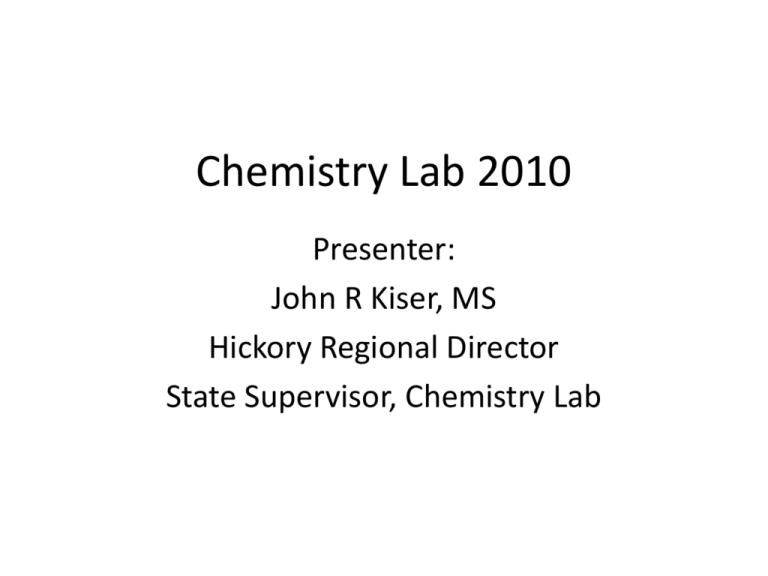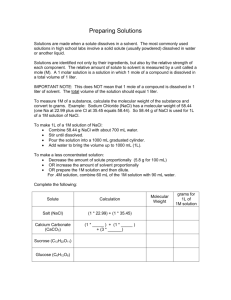
Chemistry Lab 2010
Presenter:
John R Kiser, MS
Hickory Regional Director
State Supervisor, Chemistry Lab
Introductions
•
•
•
•
Topics for 2010: Kinetics and Solutions
Regional vs State Topics
Safety Requirements
Must bring calculator!
Need to know topics
• Formula Writing/Nomenclature
• Mole & Stoichiometry Calculations
Solution Terminology
• Solution: Homogeneous mixture
• Solvent: Component in greater/greatest amount
• Solute: Component(s) in lesser/least amount
Factors that influence solubility
• Polarity of Solute and Solvent –
“Like Dissolves Like”
Polar solutes dissolve in polar solvents
Nonpolar solutes dissolve in nonpolar solvents
Nonpolar solutes do not dissolve well in polar solvents
• Temperature
Solubility of most solids in water increases with temperature
Solubility of gases in water decreases with temperature
• Gas Pressure
As the pressure of a gas above a solution increases, the
solubility of the gas in the solution increases. (Henry’s Law)
Sweet Tea and Soft Drinks
Amounts of Solute in Solution
• Saturated: The maximum amount of solute is dissolved in the
solvent
• Unsaturated: Less than maximum amount of solute is
dissolved in the solvent
• Supersaturated: More than the maximum amount of solute is
dissolved in solvent
• To obtain a supersaturated solution, you heat solution until all
solute dissolves. Carefully and slowly cooling the solution
keeps all the solute dissolved in solvent.
• Solubility curves show maximum amount of solute that can be
dissolved in 100 mL of water at a particular temperature.
Above curve = supersaturated, Below curve = unsaturated
Saturation
• What is the solubility of Sodium Acetate at 60 oC?
• What mass of sodium acetate will dissolve in 250 mL of water
at 60 oC?
• Is 40 grams of sodium acetate in 50 mL of water at 60 oC
saturated, unsaturated, or supersaturated?
Units of Concentration
Molarity (M) =
Moles of solute
Liters of solution
Mass Percent =
Mass of component
Total mass of solution
Molality (m) =
Moles of solute
Mass of solvent (kg)
Copyright © 2010 Pearson
Prentice Hall, Inc.
x 100%
Units of Concentration
Assuming that seawater is an aqueous solution of NaCl, what is its molarity?
The density of seawater is 1.025 g/mL at 20 °C, and the NaCl concentration is
3.50 mass %. 3.50 mass % = 3.50 grams of salt in 100.00 grams of solution
Assuming 100.00 g of solution, calculate the volume:
1 mL solution
100.00 g solution
x
1.025 g solution
1 L solution
x
= 0.09756 L solution
1000 mL solution
Convert the mass of NaCl to moles:
3.50 g NaCl
x
1 mole NaCl
= 0.0599 moles NaCl
58.4 g NaCl
Then, calculate the molarity:
0.0599 moles NaCl
= 0.614 M NaCl
0.09756 L solution
Units of Concentration
In the previous example, what was the MOLALITY (m) of sodium chloride in
seawater? Assume seawater contains only sodium chloride and water.
Calculate the mass of water (solvent) in kg:
100.00 g solution – 3.50 grams NaCl (solute) = 96.50 grams water (solvent) = 0.09650 kg
Convert the mass of NaCl (solute) to moles:
3.50 g NaCl
x
1 mole NaCl
= 0.0599 moles NaCl
58.4 g
Then, calculate the molality:
0.0599 moles NaCl
= 0.621 m NaCl
0.09650 kg Solvent
Concentrations - ppm
Mass of component
Parts per million (ppm)=
(Mass based) Total mass of solution
x 106
50 ppm means a solution contains 50 grams of solute in 106
grams of solution (50 mg in 1 kg solution)
In dilute aqueous solutions at 25 oC, ppm is also equivalent to
mg solute in 1 L solution
Solving for Unknown Concentration:
Density
• Density of solution increases as solute
concentration increases.
• The plot of density of solution versus
concentration of solution should be linear.
• Can be used to solve for an unknown
concentration.
• Example: Sugar concentration in Juice
Solving For Unknown Concentration:
Titrations (Volumetric Analysis)
In a titration a solution of accurately known concentration is added
gradually added to another solution of unknown concentration until
the chemical reaction between the two solutions is complete.
Indicator – substance that changes color at (or near) the
equivalence point
Equivalence point – the point at which the reaction is complete
Sometimes called stoichiometric point
Endpoint – The point at which the indicator changes color
Slowly add
reactants
UNTIL
the indicator
changes color
4.7
Steps for Solving Titration Problems
STEP 1: Write the correct chemical equation
STEP 2 Determine moles of starting compound
STEP 3: Determine moles of desired compound
STEP 4: Solve the problem
Example Problem: Titration of Citric Acid in Fruit Juice
3 NaOH (aq) + H3C6H5O7 (aq) → 3 H2O (l) + Na3C6H5O7 (aq)
Solving for Unknown Concentration:
Lambert-Beer
• Lambert-Beer Law: A = εbc
A = Absorbance (unitless)
b = path length (cm)
c = concentration (M)
ε = Molar absorbtivity (constant, units M-1 cm-1)
Lambert-Beer or Beer’s Law Plot:
Provided all absorbance measurements are made on
the same spectrophotometer with the same cell, a
graph of absorbance vs. concentration will be linear.
Example: Copper (II) ion concentration
Using Concentrations to Find
Molar Mass: FP Depression
• Adding a solute to a solvent decreases the freezing point
∆Tf = kf*m
∆Tf = decrease in freezing point
kf = Freezing point constant (1.86 oC m-1 for water)
m = molality
Assumes ideal behavior and that solute is NOT ionic.
How to use to find molar mass of solute:
• Use ∆Tf and kf to find molality of solution
• Use mass of solvent to find moles solute present
• Mass solute dissolved divided by moles solute gives the molar
mass of solute!
Freezing Point Depression Example
When 2.50 grams of a covalent compound is dissolved in 0.100
kg of water, the freezing point is determined to be
-0.750 ⁰C. What is the molar mass of the compound?
(Assume Ideal Behavior)
Molality =
∆T
=
0.750 ⁰C
= 0.403 m
Kf
1.86 ⁰C m-1
0.100 kg water * 0.403 moles solute = 0.0403 moles solute
1.000 kg water
Molar mass= 2.50 grams solute
= 62.0 grams per mole
0.0403 moles solute
Chemical Kinetics
Collision Theory
A chemical reaction occurs when
• Collisions between molecules have sufficient energy to break the bonds in
the reactants.
• Molecules collide with the proper orientation.
• Bonds between atoms of the reactants (N2 and O2) are broken, and new
bonds (NO) form.
• Energy needed to start the reaction (break reactant bonds) is called the
Activation Energy (Ea)
What Prevents Collisions From Not
Resulting in a Reaction?
A chemical reaction does not take place if the
• Collisions between molecules do not have sufficient energy to
break the bonds in the reactants.
• Molecules do not collide with proper orientation.
Kinetics – Measuring Rates
• The Rate of a reaction is measured by:
Change in concentration divided by change in time
Reaction Rates and Stoichiometry
2A
B
Two moles of A disappear for each mole of B that is formed.
∆[B]
1 ∆[A]
rate =
rate = ∆t
2 ∆t
aA + bB
cC + dD
1 ∆[A]
1 ∆[B]
1 ∆[C]
1 ∆[D]
rate = ==
=
a ∆t
b ∆t
c ∆t
d ∆t
Ways to Define the Rate of the Reaction
Br2 (aq) + HCOOH (aq)
2Br- (aq) + 2H+ (aq) + CO2 (g)
slope of
tangent
average rate = -
∆[Br2]
∆t
=-
slope of
tangent
slope of
tangent
[Br2]final – [Br2]initial
tfinal - tinitial
instantaneous rate = rate for specific instance in time (slope of tanget line)
Initial rate = rate at very start of experiment
13.1
Reaction Rates
2N2O5(g)
4NO2(g) + O2(g)
Chapter 12/21
How Can Collision Theory Be Used to
Increase Rate
Increasing the concentration of reactants
• Increases the number of collisions.
• Increases the reaction rate.
Increasing the temperature of reaction
• Increases average kinetic energy of molecules
• Increases the force of collisions
• Increases collisions with enough energy to break reactant
bonds.
Collision Theory and Rate
The States of Reactants tend to also affect reaction rate:
• All solid reactants, reactants held firmly in place, little
collisions can take place.
• Gas, Liquid, or Aqueous – Particles can move more freely to
have collisions.
Related is Surface Area
• Increasing surface area of solid generally increases rate.
• More solid surface is ready to react, more collisions,
increasing the rate.
Catalysts
A catalyst :
• Increases rate of a reaction.
• Lowers the energy of activation.
• Lower activation energy means that more collisions occur
that break reactant bonds
• Is not used up during the reaction
• Biological catalysts are called enzymes
Rate Laws
Rate laws are always determined experimentally.
Reaction order is always defined in terms of reactant (not
product) concentrations.
General Form of Rate Law:
Rate = k [Reactant 1 ]x [Reactant 2]y etc…
k = rate law constant (only at particular temperature)
With respect to individual reactants, the exponents in the rate law
represent the order with respect to that reactant.
Expressing the Rate Law
First order: Exponent is 1
Second order: Exponent is 2
Zeroth order: Exponent is 0 (not in the RL!)
Overall order: Sum of exponents
The order of a reactant is not related to the stoichiometric
coefficient of the reactant in the balanced chemical
equation.
The Rate Constant
The rate law constant k is only valid at a particular temperature.
k =
Rate of Reaction
[Reactant 1 ]x [Reactant 2]y …
If the overall order of the reaction is z,
units for k are M 1-z s-1.
Results in rate of reaction having units of M s-1
Determining Order of Reaction:
Initial Rates Method
• One method to determine the exponent (order of reaction) is
to change initial concentrations of each reactant.
• Measure how initial rate changes as concentration of each
reactant is changed.
• Zeroth order = concentration doubles, rate unchanged
• First order = concentration doubles, rate doubles
• Second order = concentration doubles, rate quadruples
Remember that rate is change in concentration divided by time.
Just looking at time changes can lead to wrong answer!
When two experiments are being compared, remember to make
sure only one reactant has a change of initial concentration
Determine the rate law and calculate the rate constant for the following reaction from
the following data:
NO2 (g) + CO (g)
NO (g) + CO2 (g)
Experiment
[NO2] M
[CO] M
Initial Rate
(M/s)
1
0.10
0.10
2.2 x 10-3
2
0.20
0.10
8.8 x 10-3
3
0.20
0.20
8.8 x 10-3
As NO2 doubles, rate quadruples, so second order with respect to NO2
As CO doubles, rate is not changed, so zeroth order with respect to CO
Rate = k [NO2]2[CO]0 = k [NO2]2
Overall order is 2+ 0 or 2
k=
2.2 x 10-3 M s-1 = 0.22 M-1 s-1
(.10 M)2
13.2
Determining Order of Reaction:
Linear Plot Method
A second method for determining order of reaction is linear plot
method
Monitor concentration of one reactant (A) versus time
• If [A] vs t is linear, 0th order with respect to A, slope = -k
• If ln [A] vs t is linear, 1st order with respect to A, slope = -k
• If [A]-1 vs t is linear, 2nd order with respect to A, slope = k
Considerations
• [A] should be relatively small compared to the concentration of
other reactants.
• Unless A is the only reactant, k is called “pseudo-rate constant“
• To find order with respect to other reactants, vary their
concentration and notice change of A. Use initial rate method.
Integrated Rate Law
• Obtained from rate law via calculus
• Can also be determined from linear plot
• Use to predict concentration of a reactant at a
certain point in time
• Please see “Kinetics Reference Sheet”
Linear Plot Method Activity
Zero and First order reactions
Thank you!
Please email me at jkiser@wpcc.edu
For follow-up questions, concerns, etc..







